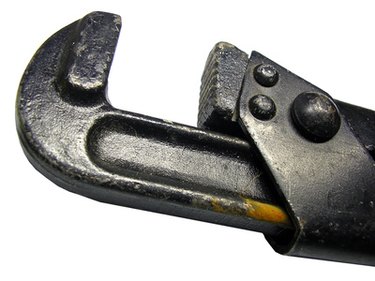
The pipe wrench, also known as the Stillson wrench, is a specialized type of gripping and turning tool that the American machinist Daniel C. Stillson patented in 1869, according to Pipe Wrench Guide. Today, plumbers still rely on the wrench for holding pipes still, twisting pipes loose and screwing sections of pipe together. The pipe wrench consists of very few individual parts, but all play vital rolls in the wrench's function.
Handle
Video of the Day
The handle, or arm, of the pipe wrench is the component that provides the tool with torque, allowing you to generate a powerful, twisting force. As you turn the wrench handle, the jaws of the wrench grip tighter and tighter around the pipe or other object your are applying force to. It is an example of a lever-and-pivot system, wherein the handle is the rigid lever, which rests upon the pivoting jaws. According to Pipe Wrench Guide, steel and aluminum are the two most popular materials that manufacturers use for constructing pipe wrench components. This is especially true when it comes to constructing the handles, as they need to be incredibly strong.
Video of the Day
Jaws
Pipe wrenches feature two distinct jaw sections: the bottom jaw, or heel jaw, which is the horizontal surface on top of the handle, and the top jaw, or hook jaw, which is a separate, hook-shaped piece that fits into a slot next to the heel jaw. At then end of the hook is a horizontal surface, which clamps down flush with the horizontal surface of the heel jaw. Both jaw surfaces feature distinctive teeth or treads, which are elevated rows of spikes that help the pipe wrench bite into metal piping and other materials. While the heel jaw is always stationary, as it is fused to the handle, the hook jaw is adjustable, allowing you to fit the jaws snugly over pipes and other objects of varying diameters.
Nut
The nut of a pipe wrench is the rotating metal piece located just below the slot next to the heel jaw, and wraps around the bottom part of the hook jaw. It is the component that allows you to adjust the height of the hook jaw. For example, if you need to wrap the wrench around a wide object, you loosen the nut, slide the hook jaw up—away from the heel jaw—and then re-tighten the nut. For a narrower grip, you can loosen the nut, slide the hook jaw down—toward the heel jaw—and re-tighten it. Most nuts have circular grooves or other surface indentations and protrusions, which allow you to grip and turn them with your thumb.